



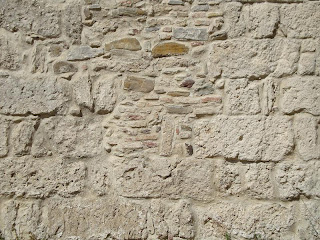

































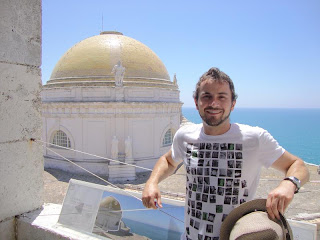




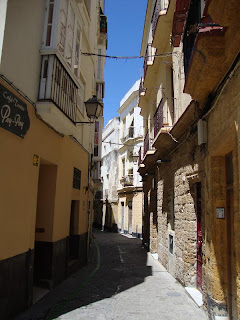















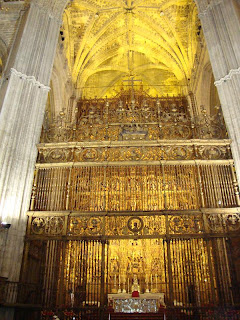








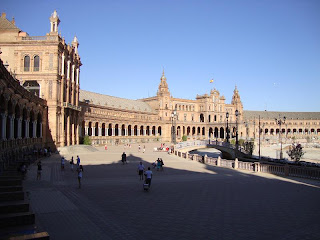




















This blog entry is not going to be a blow by blow account as I think this holiday was more about soaking up the Spanish culture rather than seeing every single thing. So I will simply state a fact and give you, the best instance (place or situation). This blog entry encompasses my 2 week travel around Andalucia (spains most Southern province) from the 27th of July until the 8th of August. My loop of Andalucia took in the following city’s/ towns ; Malaga-Ronda-Sevilla-El Puerto de Santa Maria-Cadiz-Algeciras-Tarifa-Gibraltar (UK) and back to Malaga.
The hottest city:
Seville: Inland, not much wind, I think we had one day at 42 deg, which according to the locals was just an average day. They had had days in excess of 50 deg! To be fair, I don’t think it dropped below 30 for the entire trip. Roughly double the temperature of Scotland!
The biggest rip-off:
In Ronda I sat down for a meal. The menu I interpreted in Spanish as saying they don’t believe in putting prices on the menu, as they try to use the fresh ingredients and whatever is in season. I had a lovely three course meal, with pescado (fish) as the main. But I almost choked on my olive, when they brought out the bill for 50 Euro, lesson learned! The next three days I ate noodles for dinner!
The best view:
A tough one... But the prize would have to go the UK. Yes, you guessed it the rock of Gibraltar. A small rocky peninsula owned by the British. It is a very strategic point geographically for the British, hence the reason, why they won’t give it up to the Spanish. The rock has sheer cliffs on the eastern side, at its highest point it reaches roughly 1300 feet. The best way up it is via cable car. From the top you can see about 50 tankers in the Bay of Algeciras, Mainland Spain and Africa.
Worst queue:
One and half hours waiting in the baking heat for the cable car up the rock of Gibraltar. Some slimey Italians tried to push in front of us, but we soon sorted them out. The wait was worth it for the view.
Best Museum:
Plaza de Torres de Ronda, The bull fighting ring in Ronda. It is one of the oldest operational bullfighting arenas in Spain. The museum housed bull fighting memorabilia, artwork and a section on old styled rifles. Really fascinating.
Best Beach:
Tarifa, the home of Kite Surfing. Beach was cigarette butt free, unlike some of the other crowded beaches in Spain. The water was clean and refreshing. The only downside was the wind was blowing and gusting like a force 5 hurricane. This made reading a book and relaxing difficult! Tarifa is an interesting place, it’s really close to Africa (only 14km to Morocco), and it also separates the Mediterranean Sea from The Atlantic Ocean. In the morning I went for a swim in the Atlantic and in the afternoon I tried the Mediterranean!
Best traveller:
Justin from Australia. We were heading in the same direction, so we teamed up. So I never was really on my own throughout the trip.
Best Buzz:
Numerous incidents of feeling that I wasn’t just another non-spanish speaking tourist. Like when someone on the street asked me for the time in Spanish, and he didn’t give me the ‘this guy doesn’t speak Spanish look’ after I had successfully replied (or at least I thought he did, he did look a bit wacked out on drugs). Also, ordering at restaurant’s, talking about the weather with the Spanish lady at the supermarket, asking an old lady where she was going when sitting waiting at the bus stop. And there were more...
Best Spanish Custom:
Siesta time: Everything closes down between the hours of 2 and 5 pm due to the heat.
Most Authentic Spanish town:
El Puerto De Santa Maria, the home of Sherry! I didn’t actually mean to go to this place at all, but It turned out to be almost the best part of the trip. I was actually trying to book accommodation in the more recognized town of Cadiz. But because cheap accommodation was non-existent in Cadiz I had to get creative and look further afield. I could reach Cadiz from El Puerto De Santa Maria by ferry. There, I stayed 2 nights at a small but friendly hostel (El Baobab), run by Argentineans, most of the occupants were from Spanish speaking countries. My Aussie mate Justin and I went out on the town with the receptionist Kathy and had a great night drinking mojitos at the bar with 3 metre straws until 3 in the morning. The second night the owner of the hostel Celcilia took us to an open-air cinema and we watched a German film in Spanish subtitles (or the start of it anyway!) It was amazing how busy town was at midnight, with families sitting out at restaurants, with performers on guitars serenading them in the streets. It was good hanging out with the locals and they forced us to speak Spanish!
The best cathedral:
Would have to be the Seville Cathedral. A monster of a church, the 3rd largest church in the world after Saint Peters Bascilica and St Pauls. The cathedral was built to demonstrate Seville's wealth, as it had become a major trading center in the years after the Reconquista. The builders of the cathedral decided in July 1401 to build a new temple, as the ancient Muslim mosque was in bad shape after the 1356 earthquake. According to the oral tradition of Seville, the decision of members of the chapter was: "Let a church so beautiful and so great that those who see it built will think we were mad". The Cathedral also serves as the burial site for Christopher Columbus. The builders of the Church used some columns and elements from the mosque, and most famously the Giralda, a minaret converted into a bell tower. The Giralda is the city's most famous symbol. It has height of 105 metres, and after you climb the ramps (designed so horses could go up the tower) you get superb views over Seville. It was built as a minaret of the old mosque, although the bell tower and spire top, is Renaissance.
Best Spanish Dish:
Seafood Paella in Malaga. Run by the Picasso’s Corner hostel. Cooked by Brazilian Fabio. It was superb with a sangria.
Best History Lesson
Walking tour in Sevilla: Here is my 2 paragraph, version. Let’s start in the AD with the rise of the Roman Empire, who introduced spain to all things Roman, like pillars, baths and Amphitheatres. When the empire crumbled the Visigoths (Christian/Germanic people) took over the peninsula and united it. Then the Muslims invaded from North Africa, and conquered Spain. They hung around for 600 years, and left a definite Islamic mark on the place, in the form of blood, palaces and ceramics. Then the Christians rode in from the North and gave the muslims the ‘heave ho’ on a crusade known Reconquista. Christian Spain suffered through the black death and many bad harvests. They needed a scapegoat so the catholic monarchs decided to persecute the Jews (termed the Spanish Inquisition). The Jews had 3 options. 1) Die, 2) Convert (and probably get killed later) or 3) Run. In Seville we walked through ‘Calle de Muerto’ (Street of death) where in one night 3000 Jews were rounded up and killed. Spain had many famous Kings and Queens over the years, Alfonso X, was popular, Pedro I, was cruel, Catholic King Felipe II didn’t like the Arabs. Seville was also where Christopher Columbus was given the funds to go on an expedition to find the ‘Indies’. He found America instead, and this brought about a period of colonisation in many countries in the Americas as a result a tremendous amount of wealth flowed back to Sevilla. In what was described as the golden age for Spain. Things kind of went downhill for Spain from there ... That’s pretty much all the walking tour touched on, as well as a few monuments and statues (no8do / Plaza de Espana)
Best performance:
Flamenco show in Sevilla. Run through the hostel it was all about a male soloist, clapping, dancing, stamping, fancy finger picking on the guitar, sweat and passion. A great night.
Worst moment:
Being lost and tired in Seville at 6.30 in the morning after a night out.
Other highlights:
• Exploring Europe’s oldest city. Cadiz. The view from the tower over the white houses was amazing.
• Enjoying Cerveca’s and Tapa’s on many occasions.
• The castle in Tarifa (castle of Guzman the good)
• The flamenco show in the plaza in Algeciras
• The Palace of Alcazar in Sevilla – Amazing ceramic, plasterworks and Gardens
• Picasso Museum in Malaga with some of his early works.
• The View from Castello Gibralfaro over Malaga was worth the sweaty climb.
No comments:
Post a Comment